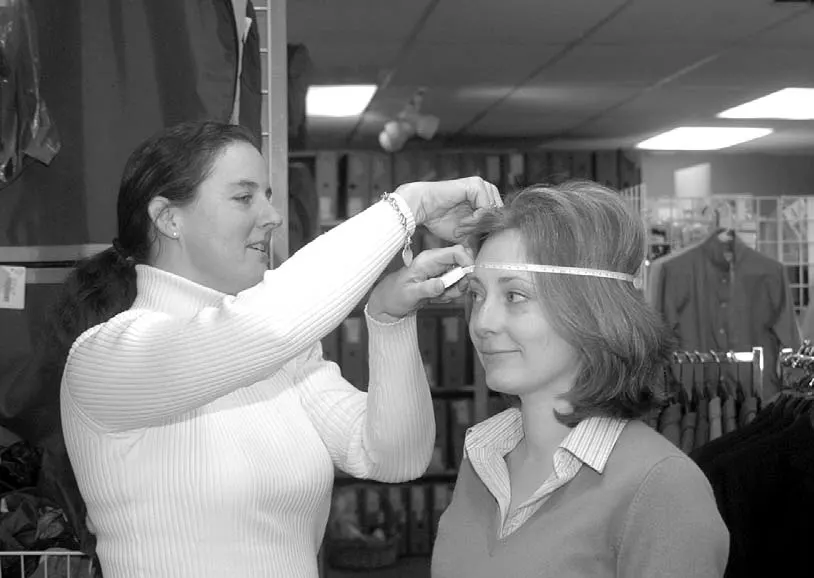If you want your ASTM/SEI-approved helmet to do its job, it’s got to stay on your head. Several experts explain how to find your perfect match.
One of the most important pieces of equipment that riders don for a session in the saddle is their riding helmet. One that doesn’t fit properly won’t function correctly and will discourage the rider from putting it on in the first place.
It’s simple: Proper helmet fit is critical to its proper functioning.
So, what is proper fit? According to Danielle Santos of The Tack Box, in Middleburg, Va., the place to start is an accurate measurement of your head. “The head needs to be measured in centimeters in order to determine the proper helmet size,” she said.
Penny Hubbard, from helmet manufacturer Charles Owen, agreed. She recommended placing the end of the measuring tape at the temple to begin, then circling the head one-finger width above the eyebrows, across the forehead. This measurement should get you within a hat size or two of what will fit you comfortably.
Measuring the head is something most people can do for themselves, but many tack store employees are now being trained in helmet fitting and can obtain a more accurate measurement of your head.
Once properly measured, it’s time to start shopping. While looking through catalogs is a good way to get an idea of what kind of helmet you want, it almost always works best to go to a shop with a fairly large selection in order to insure a proper fit.
Berk Lee, the owner of The Tack Box, pointed out, “The size of the head is a good place to start, but it’s just a guideline, not a definite. It’s much better to go to a store with a trained staff and a variety of helmets, rather than ordering one in the mail.”
And hair is a critical factor when trying on helmets.
“The customer should be prepared to put her hair up in the manner they intend to wear it with the helmet when they go shopping,” said Hubbard.
Riders with long hair need to pay particular attention to how their helmets fit. “Ideally, your hair should be worn up and as flat as possible, such as the two-hairnet method favored in the hunter ring, in order to alter the hat size as little as possible,” Hubbard continued.
Riders with long hair who like to wear their hair one way on a daily basis, such as down their backs, and another way in the show ring should consider investing in two helmets.
Turn Upside Down
ADVERTISEMENT
Once a helmet is seated on the head, it should fit snugly, but without causing discomfort. Santos recommended turning your head upside down with the helmet on and the harness unfastened. “If the helmet stays on, then it’s snug,” she said.
Frank Horn, former manager of Dominion Saddlery, Middleburg, Va., concurred.
“A helmet shouldn’t cause a headache, but you should be able to turn your head upside down and shake it without dislodging the helmet.”
Lee referred to the “eyebrow wiggle.”
“If you put a helmet on your head and shift it forward and back, a properly fitting one should wiggle your eyebrows up and down,” she said.
Hubbard advised, “Once the helmet is seated on the head, it should rest above the ear and the eyebrows. You shouldn’t be able to get a finger in between the helmet and your head.
The helmet should also not interfere in any way with your line of sight.”
Added Santos, “A helmet must be snug, and it shouldn’t interfere with your ability to ride. It shouldn’t push your ears out or give you a headache.”
Not There To Compensate
The harness and chinstrap are two important components of how well a helmet fits.
“It should be snug, with room to fit one finger between it and your chin,” said Hubbard. “It should also hang beneath the chin, rather than rest on the point.”
The purpose of the chinstrap is not to hold the helmet on the wearer’s head during normal use. Its job is to hold the helmet to the head during a fall. The harness and chinstrap cannot be used to compensate for an improperly fitted helmet.
“We’ve all seen riders with helmets rattling on the back of their heads, held on only by the chin strap,” said Hubbard. “A helmet worn this way offers limited protection if you fall.”
ADVERTISEMENT
Although the majority of riders can be fit properly with helmets they buy off the shelf, there are custom-fitting services available.
Helmets offer a custom-made lining, designed from a mold of the head.
Children, with their growing heads, can be a bit more difficult to fit, but with a bit of shopping, a comfortable helmet is out there to be found.
Horn, who fits many children through his involvement with the Casanova-Warrenton Pony Club (Va.), explained the sound he hears that tells him the helmet fits properly, especially with kids.
“It’s hard to describe. You hear it when you set a helmet on a child’s head, almost a vacuum-like sound, which lets you know it’s a good fit,” he said.
Santos recommended that children take a potential helmet home and wear it for the evening. “Have them wear it while doing homework or watching television,” she suggested. “If it doesn’t give them a headache, but fits snugly, then it’s a good fit.”
Horn pointed to the “dial-a-fit” option built into several brands of helmets as a reasonable solution to fitting a growing head.
This feature, with its dial located in the back of the helmet, allows the wearer to adjust the tension of the helmet to suit his or her comfort.
Lee suggested that this type of helmet is one way to get around the hair issue. Riders can adjust the helmet to allow for whatever hairstyle they want to wear.
The bottom line when it comes to proper helmet fit is that riders should forget that they’re even wearing a helmet as soon as they put it on.
“If your helmet is rattling around on your head, or tipping into your eyes, or giving you a headache, then it’s not doing its job,” said Hubbard. “It must fit properly to obtain the complete physical and psychological benefits that it has to offer.”















